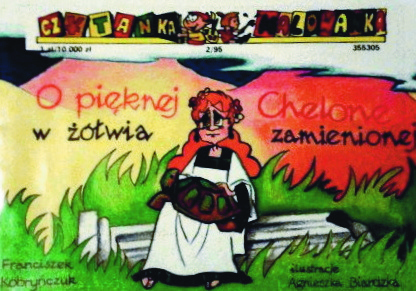Title of the work
Country of the First Edition
Country/countries of popularity
Original Language
First Edition Date
First Edition Details
Franciszek Kobryńczuk, O pięknej Chelone w żółwia zamienionej, ill. Agnieszka Biardzka, Czytanka-malowanka 2/95. Warszawa: Oficyna Wydawnicza Ostoja, 1995, 20 pp.
ISBN
Available Onllne
O pięknej Chelone w żółwia zamienionej at ewa.bicom.pl (accessed: September 21, 2022).
Genre
Narrative poetry
Poetry
Target Audience
Children
Cover

Courtesy of the publisher.
Author of the Entry:
Maciej Skowera, University of Warsaw, mgskowera@uw.edu.pl
Peer-reviewer of the Entry:
Katarzyna Marciniak, University of Warsaw, kamar@al.uw.edu.pl
Elżbieta Olechowska, University of Warsaw, elzbieta.olechowska@gmail.com

Photograph courtesy of the Author.
Franciszek Kobryńczuk
, 1929 - 2016
(Author)
A veterinarian, professor of veterinary sciences specializing in animal anatomy (an authority on the anatomy of the Polish bison), writer, and poet. 1948–1950: a member of a secret youth organization active within the post-WW2 underground connected to Armia Krajowa [Home Army], banned by the Communist regime; in 1950 he was sentenced to a 10-year prison term for this activity; fully exonerated after the fall of Communism. Graduated from the Faculty of Veterinary Medicine of the Warsaw University of Life Sciences (SGGW); from 1994 to 2000 Head of the Department of Animal Anatomy at the same University. Debuted as an author for children in 1958 with a short poem Sowa [Owl], published in children’s magazine “Miś”; contributor to several other magazines for children and young adults, such as “Świerszczyk,” “Płomyk,” “Płomyczek,” and “Mały Apostoł”; author of about 30 books for children, young adults and adults; a former member of the Polish Writers’ Union; now his poems can be found most of all online. The page ewa.bicom.pl/wierszedzieci run by a Kobryńczuk’s admirer, Ewa Białek, functions as the official website for Kobryńczuk’s poems for children.
Source:
Materials kindly provided by the Author.
Bio prepared by Maciej Skowera, University of Warsaw, mgskowera@gmail.com
Summary
Based on: Katarzyna Marciniak, Elżbieta Olechowska, Joanna Kłos, Michał Kucharski (eds.), Polish Literature for Children & Young Adults Inspired by Classical Antiquity: A Catalogue (accessed: June 11, 2021), Faculty of “Artes Liberales”, Warsaw: University of Warsaw, 2013, 444 pp.
Zeus and Hera are about to marry; Hermes is ordered to invite gods, animals and people from all over the world for the wedding. During his journey, Hermes also finds the tiny hut of a nymph named Chelone. She declines Zeus’ invitation because she prefers to remain in her own home. Hermes tells Zeus about the nymph’s refusal. The angry Zeus sends Hermes again and tells him to transform Chelone into a turtle, should she refuse again. She obstinately declines and is transformed into a turtle, as Zeus decreed. The poem is illustrated with black and white images that children can colour.
Analysis
This poem, like many other works by Franciszek Kobryńczuk, a specialist in zoology, focuses particularly on the relationship of the Greek gods (and other beings, such as nymphs) to the natural world. This is particularly evident in the many enumerations and comparisons used by the author: the gods live “in the mountains, forests, rivers, and lakes,”* Zeus and Hera’s wedding is to be attended by “owls, ravens and eagle-owls, roe deers, foxes, moles, hedgehogs, martens, wolves, raccoons, snakes, frogs, bats,” there are “violets, cornflowers, wild lilies” growing around Chelone’s household, and Hermes is quick as a bird. The writer’s interest in the natural world harmonizes perfectly with the main theme of this retelling: the transformation of a nymph into an animal, a turtle. In this way, the story of metamorphosis is encased in a natural environment, which may encourage one to read the work in an ecocritical optic – as a poem that speaks as much about a mythological transformation as nature, and how it is subject to constant change. All the more so, since the poem finishes, in keeping with the ancient explanation of natural phenomena by reference to supernatural ones, “Many of the characters of yesteryear are now embodied in animals.”
* All quotations translated by Maciej Skowera.
Further Reading
Entry: “Chelone (Khelone)” on theoi.com (accessed September 13, 2022).
Nosek, Anna, W przestrzeniach universum i regio. Wiersze dla dzieci współczesnych pisarzy regionu podlaskiego – interpretacje [In the Spaces of universum and regio: Poems for Children by Contemporary Writers of the Podlasie Region – Interpretations], Białystok: Wydawnictwo Uniwersytetu w Białymstoku, 2015.
Addenda
In Ancient Greek, χελώνη [khelṓnē] means ‘turtle,’ ‘tortoise,’ which is used in taxonomical nomenclature for both plants (e.g., the genus Chelone) and animals (e.g., the genus Chelonia within the family Cheloniidae).


